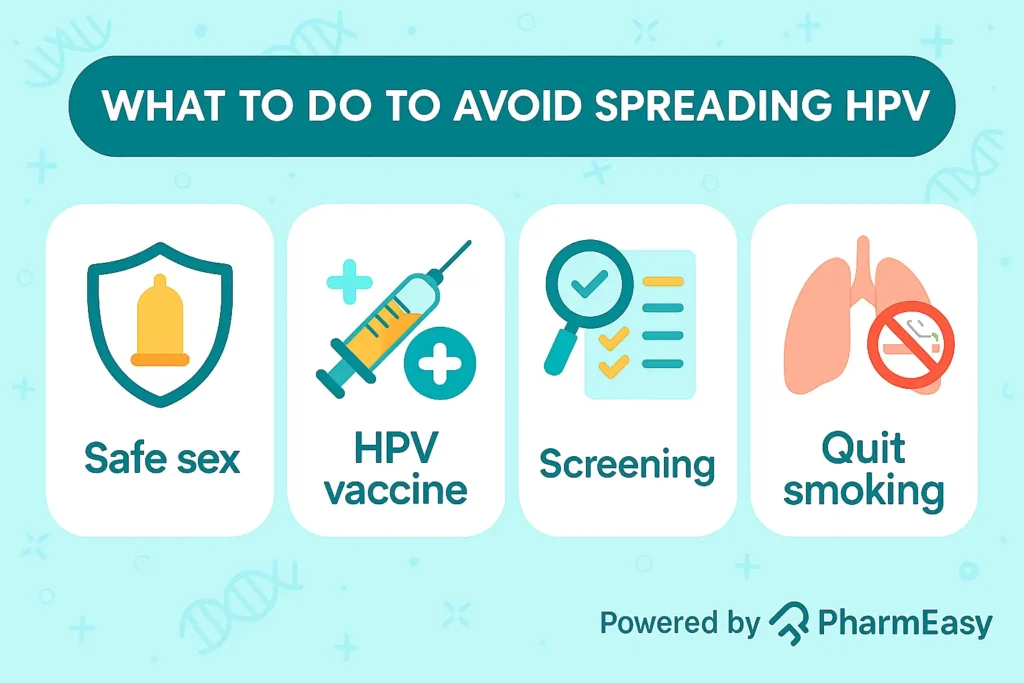HPV in Men: What It Is, Causes, Symptoms & Treatment
By Dr. Vishesh Bharucha +2 more

Get,

to manage your symptom
Get your,


4 Cr+ families
benefitted

OTP sent to 9988776655



You’ve successfully subscribed to receive
doctor-approved tips on
Whatsapp

Get ready to feel your best.

Hi There,
Download the PharmEasy App now!!


Register to Avail the Offer
Send OTPBy continuing, you agree with our Privacy Policy and Terms and Conditions

Hi There,
Sign up on PharmEasy now!!
Trusted by 4 crore+ families

OTP sent to 9988776655



You have unlocked 25% off on medicines




Code: NU25
By Dr. Vishesh Bharucha +2 more
Table of Contents
HPV (Human Papillomavirus) infection is a sexually transmitted infection commonly affecting both men and women. Some types of HPV are considered low-risk and may cause warts, while others are high-risk types and that can even lead to cancer.
HPV is more often discussed in women due to the risk of cervical cancer. However, there a 90% probability of men too being infected with HPV through their lifetime. Though not always serious, it can sometimes cause cancer of the penis, anus, or certain parts of the throat, such as the base of the tongue and tonsils1.

In this blog, we will focus on HPV in men, how to get tested and manage this infection.
HPV is a virus that infects the surface layers of the skin and mucus membranes (thin linings) of the body areas like the genitals, anus, and parts of the throat, commonly spread through sexual contact. It can cause infections in these areas of skin with minor or sometimes even no symptoms, especially in cases of genital infection. The rate of HPV in men is high throughout their lives, while in women, the infection rate reduces as they age.
There are over 200 HPV types and are mainly classified as: the low-risk type (like HPV-6, 11) the high-risk type (like HPV-16, 18) of HPV. Women are infected more often with the high-risk type, while in men, both the high- and low-risk types are equally common1,2.
HPV is easily spread from one person to another in different ways, such as:
The risk is higher in men who have sex with men, in those who are HIV-positive, or in those with infected partners. In rare cases, HPV can also pass to a unborn children through sperm or egg, leading to infection3.
HPV infections can be concerning for men because they often have no symptoms, and many are unaware that they have an infection which can easily pass to their partners.
In men, the low-risk type HPV can cause warts (growths on skin) on gentiles or mouth/throat, but the high-risk type can lead to more serious health issues like cancers affecting the skin around the penis and anus and some mouth/throat cancers. Some research studies also suggest that HPV may affect sperm quality in men, although a clear link has not been proven yet.
Moreover in men, the immune response to HPV is often less effective in clearing the virus completely, and it may remain in the body or come back later. This means the virus can stay for a long time in the body or become active again, causing reinfection and unintentional spread to their partner.
Unlike for women who have HPV related cervical cancer screening, there is no regular screening for the HPV test for men. However, the risk of HIV infections is higher in some categories of men such as those who have sex with other men or those with HIV3,4.
Therefore, though HPV is commonly spoken about in women, men may also have serious health issues when infected with HPV and need regular HPV-related cancer screening using anal smears or HPV DNA testing, especially in certain groups4,5.
HPV is not always dangerous and often goes away without causing much trouble5. But in some cases, it can lead to various health issues like:
These risks show that it is important for men to be aware of HPV, identify the symptoms and take steps to manage it early.
Usually, men with HPV do not show many symptoms. But when symptoms are present, they depend on the type of HPV and the location of the infection. Some possible symptoms include:
These symptoms may also occur in other conditions. While there is no standard test for HPV in men, a specific test like the anal pap smear test may be advised for those who have sex with men or HIV patients. So, it is better to consult a doctor who may advise you to get the HPV test male and accordingly manage the condition based on the results1,6.
Several cancers in men are linked to the high-risk HPV type, especially HPV-16 and HPV-18. HPV is a major cause of certain throat cancers, especially those in the oropharynx (like the base of the tongue and tonsils), often seen in men with a history of oral sex. It also causes 40–50% of penile cancers and about 90% of anal cancers, particularly in men who have sex with men or in HIV-positive men. These cancers may start as small precancerous growths and progress to become cancerous1,2.
But how do men test for HPV to reduce the risk of getting these cancers? We will find it in the next section.
As of now, there are no standard HPV test for men that are approved for screening. In males without any symptoms, it is hard to test for HPV. However, HPV testing may be recommended in the following situations:
Most of the time, warts are checked by doctors just by looking at them and are diagnosed based on how they appear. Testing is usually done on warts or visible spots only if the doctor thinks it could be a serious type of HPV.
While not routinely done, anal cytology (Pap smear) can be advised for detecting HPV in men who may have weakened immune systems or those who engage in anal intercourse (high-risk categories). Here, a soft swab is used to collect cells from the anal region to check for early signs of cancer4.
Male HPV tests, particularly for high-risk categories, also include molecular tests like PCR, used to detect HPV DNA (genetic material of virus) and identify its type. Samples can be taken from areas like the penis, throat, mouth, or skin growths2.
For men who had cancer linked to HPV, their follow-up after treatment involves regular check-ups, scans, or cytology. HPV DNA test may be done only if the doctor recommends it2,6.
HPV infection cannot be cleared by any specific antiviral medicine, and there is no standard management plan. In most cases, the immune system clears the HPV virus on its own7,8,9. However, for HPV related growths and cancers, especially genital warts and early signs of cell changes that could turn into cancer, there are clear treatment options available10.
The focus is mainly on addressing visible growths and related health problems. For growths around the penis, topical creams like imiquimod may stimulate an immune response and clear the warts, though they do not remove the virus completely in that area.
Surgery, radiation, or cancer-related medicines may be suggested in cases where cancer has developed due to HPV8,9.
Immunotherapy medicines such as nivolumab, and pembrolizumab help the body’s immune system fight cancer and are used in some HPV-related cancers of certain areas of the throat11.
Managing HPV should include both partners to help reduce the chance of passing the virus back and forth8,9.
HPV vaccines may help reduce the chances of getting HPV and may lower the risk of HPV-related cancers by up to 90%. Though vaccines are often focused more on women, men may also benefit, as they experience more than 90% of certain HPV-related cancers. HPV vaccines help protect against the many high-risk types of the virus (like types 16 and 18), which can cause cervical cancers and many other cancers in the genital and throat areas.
HPV vaccines have shown strong benefits with good efficacy and immune response. In India, in 2021, Gardasil 9, a vaccine that may be given to both men and women, was introduced8.
The HPV vaccine can be given to males aged 9 to 26 years. It may also be given up to age 45, based on a person’s health and risk factors, as advised by a doctor.
For boys aged 9 to 14 years, two doses are given. The second dose is given 6 to 12 months after the first. If the second dose is given too early (less than 5 months apart), a third dose is needed.
For males aged 15 to 45 years, three doses are given. The second dose is given after 2 months, and the third dose after 6 months from the first8,12.
Getting vaccinated is one way you may help reduce the risk of spreading HPV and avoid the health risks associated with HPV.

You can reduce the chances of getting HPV and its related complications by following these tips13,14:
By taking timely action and staying aware, you and your partner may be safeguarded from serious health risks related to HPV.
Also Read: HPV in Women: Causes, Symptoms, and Treatment Options
You need to see a doctor if you observe any changes in your body or any symptoms that are unusual. This could include a new growth or lump in the genital or anal area, sometimes with pain or bleeding. If you come to know that your partner has HPV, you may ask the doctor if you can get the HPV testing for men and, also get guidance on whether the vaccine can be taken to reduce the risk of exposure6,13.
Also Read: Is HPV Herpes? Our Doctor Explains the Difference
HPV cannot be taken lightly in men, as it may lead to cancer in some cases. The symptoms may not always be visible, but being aware, taking necessary precautions, getting vaccinated, and seeking medical advice can help you and your partner stay healthy and safe.
HPV symptoms do not appear immediately after getting infected with HPV. It may take weeks, months, or even years for signs to show up6.
Genital warts are usually non-cancerous. They are typically caused by low-risk HPV and resolve on their own. However, in case of persistent lesions, it’s best to consult your doctor. They will examine the lesion and advise HPV testing if needed1.
HPV can cause genital warts and, in some cases, lead to cancers in the anus, penis, mouth, or throat, even in men. You may get your son vaccinated before the start of sexual activity. Consult your doctor to know more about the HPV vaccine and prevention strategies.
Disclaimer: The information provided here is for educational/awareness purposes only and is not intended to be a substitute for medical treatment by a healthcare professional and should not be relied upon to diagnose or treat any medical condition. The reader should consult a registered medical practitioner to determine the appropriateness of the information and before consuming any medication. PharmEasy does not provide any guarantee or warranty (express or implied) regarding the accuracy, adequacy, completeness, legality, reliability or usefulness of the information; and disclaims any liability arising thereof.
Comments

Leave your comment...
You may also like
Comments